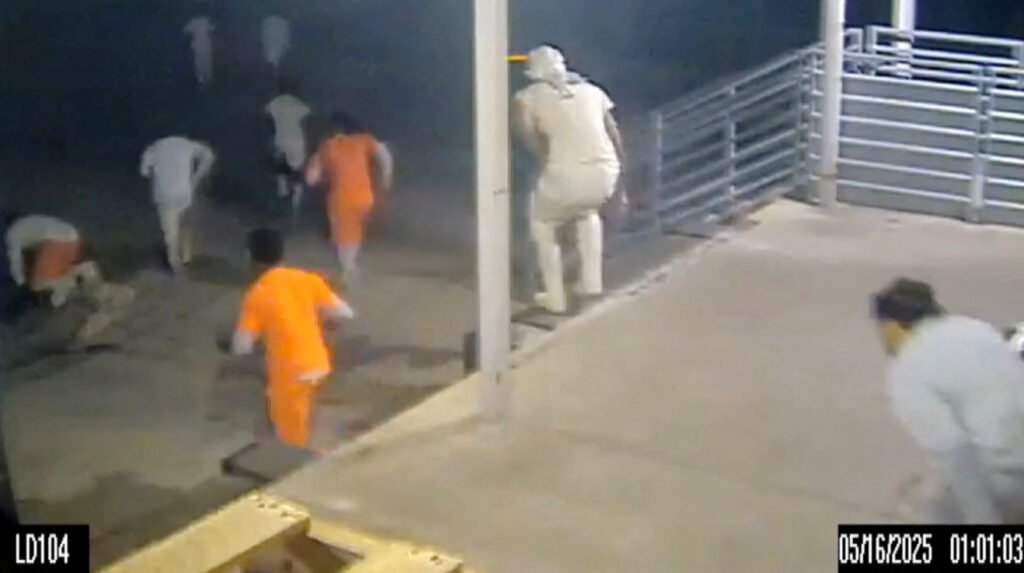Amid an intense manhunt following a brazen jailbreak, a controversy erupted in New Orleans over a surveillance system that secretly used artificial intelligence to monitor the city. Police say the system gets dangerous criminals off the streets, including one of the jail escapees. Civil liberties advocates say it’s an unwarranted intrusion into the privacy of tourists and New Orleans citizens alike.
New Orleans has been on edge since Friday, May 16, when 10 inmates broke out of Orleans Parish Prison. Six of the inmates — including one accused in a double homicide — are still unaccounted for.
Authorities arrested a jail maintenance worker on Tuesday, May 20, for allegedly aiding the escape, which went undetected for about eight hours early Friday. Newly released surveillance video shows two of the escapees, dressed in black hoodies and gray pants, calmly walking along an otherwise empty street in the city’s French Quarter on Friday. The police soon recaptured one of the two men, 20-year-old Kendell Myles, who had been jailed on charges of attempted murder and carjacking.
Investigation examines surveillance system
With the manhunt in its fifth day, The Washington Post published an investigative story about a surveillance system that scours New Orleans streets.
Unbiased. Straight Facts.TM
A New Orleans-based nonprofit claims its AI facial-recognition surveillance technology has helped police make at least 34 arrests since 2023.

Project NOLA, a nonprofit based at the University of New Orleans, applies artificial intelligence to video from 200 cameras to make real-time matches between faces in crowds to those of criminal suspects. When it detects a potential match, the system pings nearby police officers through an app on their phones. Project NOLA says the system has been responsible for at least 34 arrests since it launched in 2023, according to the Post.
However, the Post reported the police may have exceeded their authority in relying on the facial-recognition system.
The New Orleans City Council approved an ordinance in 2022 saying police officers could use a real-time facial-recognition system to apprehend only “specific suspects in their investigations of violent crimes,” the Post said.
Two examiners are supposed to review the potential facial matches before officers approach a suspect, and police officials are required to report any arrests to the City Council.
Officers have arrested at least four people charged with non-violent crimes, and they often ignore requirements for oversight by examiners and the council, according to the Post.
The Post reported that no other police department has used facial recognition technology so extensively. While no federal law governs the use of the technology, it is banned in four states — Maryland, Montana, Vermont and Virginia — and at least 19 cities.
Privacy concerns raised
Privacy advocates criticized New Orleans’ use of the technology, which they say could be used to conduct inappropriate surveillance on people who have committed no crimes.
“This is the facial recognition technology nightmare scenario that we have been worried about,” Nathan Freed Wessler, a deputy director of the American Civil Liberties Union’s speech, privacy and technology project, told the Post. “This is the government giving itself the power to track anyone – for that matter, everyone – as we go about our lives walking around in public.”
The head of the ACLU’s Louisiana branch called for an investigation.
“We cannot ignore the real possibility of this tool being weaponized against marginalized communities, especially immigrants, activists and others whose only crime is speaking out or challenging government policies,” Executive Director Alanah Odoms told the science and technology website Ars Technica.
System paused before jailbreak
In April 2025, after reporters for the Post approached New Orleans officials about the surveillance system, the police paused using real-time alerts for matches with possible suspects.
New Orleans Police Superintendent Anne Kirkpatrick told Project NOLA she needed to determine whether her department was complying with the local ordinance on electronic surveillance.
“We’re going to do what the ordinance says and the policies say,” Kirkpatrick told the Post. “And if we find that we’re outside of those things, we’re going to stop it, correct it and get within the boundaries.”
‘Seconds count’
Friday’s jailbreak put a new spin on the surveillance system.
Bryan Lagarde, the criminologist who created Project NOLA, told a New Orleans television station that his organization’s technology helped police apprehend Myles, the escapee who faced attempted murder and carjacking charges. Lagarde said Project NOLA could have located other escapees if authorities had released information on their identities earlier on Friday.
“Realistically, seconds count,” Lagarde told WVUE-TV. “Minutes count. So, the faster we can get this information to the authorities – in this case, it’s automated, mostly – the faster they can get out there, the faster they can go ahead and get that person before that person does any more harm to anyone else.”
At a news conference on Sunday, May 18, the police superintendent, Kirkpatrick, defended the use of electronic surveillance without mentioning that she had recently paused her department’s work with Project NOLA.
“This is the exact reason that facial recognition technology is so critical,” she said. “And it’s well within our boundaries of the ordinance here because we are allowed to use facial recognition technology in an event just like this. So, we are already using our technology to leverage and help us, and I believe that’s how we got an identification.”
contributed to this report.


